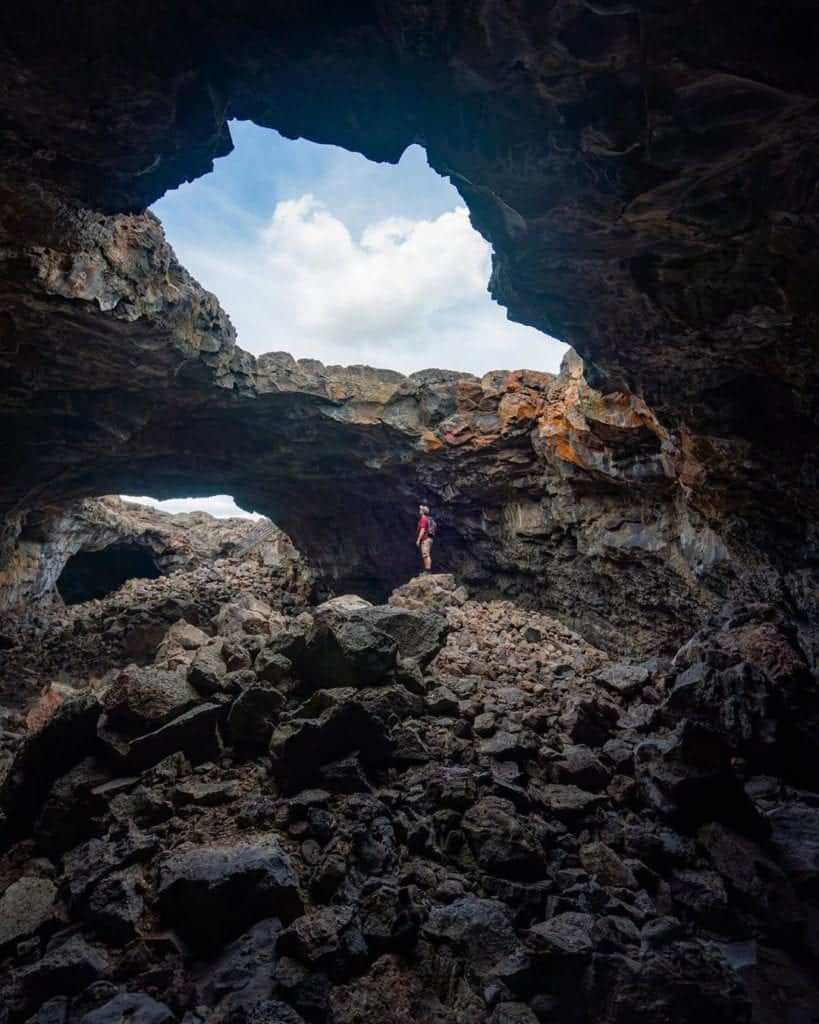Look up at the night sky in south-central Idaho’s Craters of the Moon National Monument and Preserve and you’ll feel yourself a vital part of our luminous Milky Way galaxy, a lead player among billions of stars and planets. Granted silver-tier International Dark Sky Park status by the International Dark-Sky Association (IDA) in 2017, this area is among the U.S.’ most spectacular places to stargaze and spot celestial bodies. As if that wasn’t cool enough, it also happens to be the best place on planet earth to experience what it’s like to walk on one of our closest astro orbiters—the moon.

Why? Because with its 1,100 miles of lava-etched landscapes, the Monument’s cratered surface closely resembles the moon’s, though it was formed by volcanoes rather than meteorites. And while you’ll see endless tubes and rivers of cooled lava, you won’t see very many people at all.
Craters of the Moon, for all its coolness, remains wild and remote—kind of like outer space. Despite years of individuals and organizations advocating for its designation as a National Park, the Idaho Farm Bureau’s fierce resistance has prevented the transformation from happening. So, the Monument is simply not very well known. Yet, it’s co-managed by the National Park Service and Bureau of Land Management and has all the biodiversity of Yellowstone National Park (though it’s only about a third of its size). Those facts and the Monument’s uncrowded status are excellent reasons to explore it now!
An Earthbound Training Ground for Astronauts
Prior to the 1969 walk on the moon, NASA wanted to acquaint Apollo-mission astronauts with moon-like geology and train them to identify, collect and describe the most valuable rock specimens. Given the similarity of the Craters of the Moon landscape to the actual moon’s surface, NASA experts determined that it would be the ideal place for the astronauts to undertake the required geological training and practice.
So, on August 22, 1969, the astronauts chosen for the Apollo 14 mission–Gene Cernan, Alan Shepard, Joe Engle and Ed Mitchell–took a quick trip to Craters of the Moon. They didn’t all end up on Apollo 14, which landed on the moon on Feb. 5, 1971, but everyone except Joe Engle walked on the moon on subsequent missions. The Apollo 14 crew brought back 90 pounds of lunar rocks and were no doubt able to meet the demands of their task because of the insights they gained in the Monument’s unfamiliar, harsh environment. In 1999, Cernan, Mitchell, and Engle returned to Craters of the Moon for its 75th anniversary celebration. Just think–you’ll be following in their ‘giant leap for mankind’ steps if you visit the Monument.
Layers of Lava, Cones and Caves
The Monument’s scenic seven-mile, seven-stop loop road will lead you to various overlooks that expose you to a staggering array of geologic formations (don’t let all that lava and cinder fool you into thinking this area’s a one-trick pony—it’s not). The marked stops are ideal picture-taking spots—you’ll be looking out onto huge craters, lava bombs (chunks of molten rock), twisted rope formations of lava, cinder cones (small dormant volcanoes)—and a whole lot of sagebrush, junipers, cedars and pines. You’ll also get a chance to peer into lava vents, see remnants of eons-old trees enveloped in lava and walk into lava tubes (aka caves).
Various hiking trails branch off the driving loop road and take visitors over, under and around the volcanic elements. Want to summit a volcano? Well, at Stop 4 you can. Climb the cinder path for 0.5 miles to the top of Inferno Cone and access some mind-blowing views. At Stop 5, a short hike will get you up close and personal with a bunch of miniature volcanoes, while a steep 0.5-mile walk up a part of the North Crater Trail will let you gaze into the Monument’s Big Craters. A four-mile walk on The Wilderness Trail off Stop 6 takes you to the lava trees—molds of long-gone upright trees. And the final stop, Stop 7, connects to a 0.5-mile trail that leads to five caves (a white-nose syndrome screening and permit are required for entry, and be sure to wear sturdy, closed-toe shoes).
Timing Your Trip
As the sun sets, the lava surfaces assume eye-catching silvery overtones—which definitely boost their wow factor. But once it’s dark, you’ll mostly want to look upward. Camping sites (Lava Flow Campground and Group Campground) provide a perfect perspective on the starry skies. And you can also go on a ranger-led full moon hike through the preserve or attend a Star Party, traditionally held every spring and fall. (Stop by the visitor center—the first stop on the loop road—to learn about ranger-led walks and their schedules).
The Craters of the Moon’s clear skies are a perennial lure, but the Monument’s brilliant blankets of wildflowers make late April-Sept. an extra special time to visit—peak bloom is in mid-June. It may be hard for you to imagine blackish cinder cones and lava fields coated in yellow, purple, red, blue and white hues. But the wildflowers here have adapted to survive the lack of moisture, scant soil, and extremely high temperatures. Go at the right time and you’ll spot everything from Indian Paintbrush and Dwarf Monkeyflower to Hawksbeard and Sego Lily.
Now, that’s a type of beauty you’ll never see on the moon.
